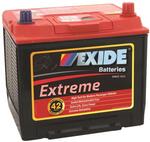Features
High technology for modern passenger vehicles
Sealed maintenance free
Extra life, extra power
Extreme reliability
Up to 42 month warranty, condition apply
Dimensions
173mm x 222mm x 233mm
Weight
Total Weight 16.0kg
Specifications
Colour
Extreme Red Top
Model Name
Exide Extreme
Model Number
X55D23CMF
Material
Lead Acid Battery
Reserved Capacity
120
Amp Hours
65
Voltage (V)
12
Cold Cranking Amps
650
Toyota Camry!
Direct competitor to the Century: 75D23L MF


Cheaper here including shipping $20.